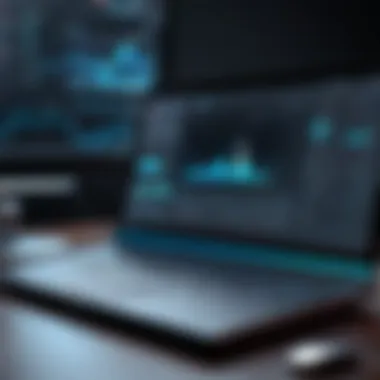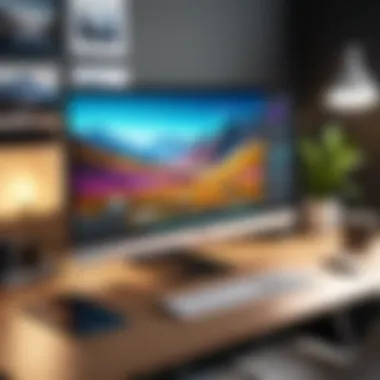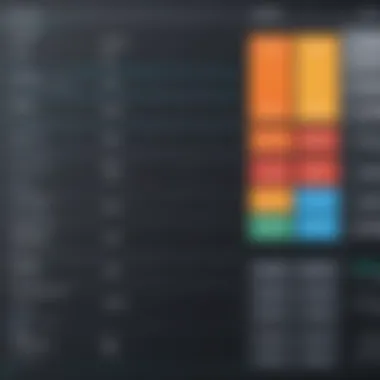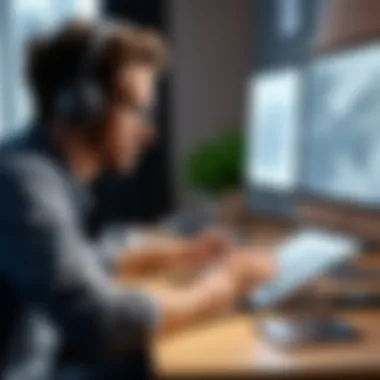Top Software Choices for Animating Your Drawings


Intro
In an age where visual storytelling reigns supreme, the importance of animation cannot be overstated. There’s something transformative about bringing still images to life, adding movement and nuance that resonates with viewers. The right software can indeed be the key to this magic, offering tools that elevate a simple sketch into a captivating animated experience.
With numerous options available, navigating the world of animation software can be daunting. Whether you’re a beginner dipping your toes into the art of animation or a seasoned animator seeking advanced capabilities, finding the right fit for your needs is crucial. In the sections that follow, we’ll dissect various software tools designed specifically for animating drawings. From user experiences to essential features, this guide aims to place a spotlight on quality solutions that can accommodate various artistic aspirations.
Let’s embark on this journey to explore the software landscape and empower you to make informed choices that will enhance your animation skills.
Prelims to Animation Software
In a world where visual storytelling reigns supreme, understanding the nuances of animation software becomes essential. The ability to breathe life into static drawings can elevate artistic expression to a level where imagination meets technology. This article aims to delve into diverse animation software that caters to both prototype creators and skilled illustrators. The focus here is to ensure that readers grasp the significance of choosing the right tools to suit their creative endeavors.
Animation is not merely about moving images; it’s about creating compelling stories, emotions, and experiences. Whether it's for a budding artist looking to experiment or a seasoned professional trying to optimize their workflow, this journey through various software applications sheds light on vital features, strengths, and overall user experiences. Just like a well-constructed narrative, the right choice in software can enhance the quality of the animation art significantly.
Understanding Animation
At its core, animation blends art and technology to convey messages through motion. Historically, animation evolved from traditional sketches, progressing through hand-drawn frames, and eventually embracing digital technologies. Many artists today scroll through the hustle and bustle of life like scenes from their own animations. They see stories lingering in everyday moments, leading them that they want to animate their drawings. This desire to animate sketches, however, demands a comprehensive understanding of what animation entails.
There are several forms of animation: 2D, 3D, stop-motion, and even experimental techniques. Each type requires different approaches and tools, tailoring the animation experience to the creator's specific needs. As such, it’s crucial for aspiring animators and seasoned pros alike to grasp these distinctions to decide effectively on the suitable software for their projects. With rich visuals, robust storytelling, and engaging characters, the essence of animation remains grounded in the creator's ability to utilize the tools at their disposal.
Importance of Software in Animation
When diving into the world of animation, software tools are as indispensable as a well-sharpened pencil to an artist. The significance of software cannot be understated; it shapes the creative process, enhances productivity, and ultimately determines the quality of the final output. Choosing the right software can significantly impact the ease of animation production, allowing for smooth workflows and enhanced creativity.
In essence, here are a few considerations for why software plays a pivotal role in animation:
- Efficiency: Different programs offer varying levels of user-friendliness and efficiency. Some may specialize in fast rendering, while others excel in fine-tuning intricate details. This variability means an animated piece can be brought to life much quicker with the right software selection.
- Toolset Availability: A robust feature set can compensate for limitations in skill level. Many programs are tailored to support novices with guided tutorials while still catering to advanced users with nuanced tools.
- Community and Resources: Well-supported software often fosters large communities where users can share ideas, resources, and troubleshooting tips. Access to forums or dedicated groups can make the journey less daunting, providing help just a click away.
- Market Trends: Staying updated with trends in animation software can help creators remain innovative in their work. As industry standards evolve, proficiency in contemporary tools could be the difference between a project succeeding or floundering.
Criteria for Selecting Animation Software
Choosing the right animation software can feel like finding a needle in a haystack. With countless options available, having a clear set of criteria helps users navigate the complexity, ensuring they pick a tool that fits their specific needs. Varying from novices to industry veterans, each user has their unique demands when it comes to animation tools. Thus, understanding key factors such as user-friendliness, feature sets, cost considerations, compatibility, and community support is essential for making an informed decision.
User-Friendliness
When diving into animation software, user-friendliness can be the make-or-break factor for many. A steep learning curve can deter even the most enthusiastic creators. Ideally, the interface should be intuitive, allowing users to familiarize themselves quickly without needing to crack a complex code. For instance, applications like Toon Boom Harmony have streamlined processes, making it easier for beginners to launch into animation without feeling overwhelmed.
Moreover, consider personal workflow styles. A drag-and-drop functionality might appeal to visual learners, while others may prefer a more traditional timeline structure. Whatever the preference, if the software is difficult to navigate, it can lead to frustrations that quash creativity.
Feature Set
The features offered by the animation software should align with the type of animations you wish to create. Not all animation projects are created equal. Some users may require advanced features like puppet animation, while others might simply need basic frame-by-frame capabilities. Adobe Animate, for instance, packs a plethora of options ranging from vector animation tools to a robust library of assets.
Also, specialized features such as customizable brushes, rigging systems, and sound syncing can significantly enhance the animation process. It's vital to check if the software comes loaded with features that match the artistic goals you’ve set for yourself. In essence, the more diverse the tools, the greater the potential for creativity.
Pricing and Affordability
It’s no secret that quality tools often come with a hefty price tag. However, that does not mean you need to break the bank. Many software options cater to various budgets, from affordable one-time purchases like Moho to subscription-based models like Adobe Creative Cloud. It's crucial to weigh the benefits against the costs and consider whether the software offers free trial periods to test before committing.
Furthermore, some platforms provide discounts for students or nonprofit organizations, making animation more accessible than ever. Keeping an eye out for promotions or bundled offers can save a pretty penny while procuring powerful tools.


Compatibility with Devices
In today's world, flexibility in accessing software is paramount. Whether you are a Windows aficionado or a Mac enthusiast, the software's compatibility with various devices plays a significant role in your choice. Some programs, like Blender, are available on multiple platforms, providing a smooth experience across different operating systems.
It's equally essential to account for hardware specifications. Resource-heavy software may require robust processing power and graphics capabilities. Familiarizing yourself with your device's specifications can guide whether your chosen software will function smoothly or leave you grappling with lag and crashes.
Community Support and Resources
Finally, community support is invaluable when navigating the intricacies of animation software. A vibrant user community can inform and inspire. Platforms like Reddit and dedicated forums often have tips, pitfalls to avoid, and shared experiences that can enhance your learning curve immensely.
In addition, consider the availability of tutorials, documentation, and learning resources. Software with rich libraries of video tutorials, such as those found on YouTube, can be a lifesaver for those who benefit from visual instruction. The presence of a supportive community can transform the experience from one of solitude to collaborative learning, where exchanging ideas and techniques becomes the norm.
"Choosing the right animation software entails thoughtful consideration of usability, features, pricing, compatibility, and community support; all factors that can significantly impact your creative journey."
Thus, by closely examining these criteria, animators can find themselves in a better position, armed with the right tools to bring their artistic visions to life.
Top Software Options for Animating Drawings
In the world of animation, choosing the right software can feel like looking for a needle in a haystack. With a plethora of options available, each boasting a unique set of features, knowing where to start can seem rather daunting. This section aims to shed light on various software tools that stand out for animating drawings, highlighting what makes each one valuable.
The importance of exploring top software options lies in understanding how these tools facilitate creativity and streamline the animation process. Whether you are an enthusiastic hobbyist or a seasoned professional, selecting the right software can greatly influence the quality of your work and your ease of use. From drawing tools and user interfaces to scripting capabilities and export options, these aspects are crucial when deciding which software fits your needs.
Moreover, as trends in animation technology evolve, so do user expectations. Tools need to be robust yet simple enough to not overwhelm the user. Hence, knowing what software excels in which area is key to making a sound decision.
Software One: Overview and Features
Software One, known as Toon Boom Harmony, is an industry stalwart favored for its comprehensive feature set. Its versatility enables artists to work on both traditional frame-by-frame animations and rig-based animations with remarkable ease. The software offers a plethora of brushes and tools for sketching that closely mimic natural drawing, allowing for a seamless transition from drawing to animation. The timeline and node-based compositing tools help in creating intricate animations without feeling cluttered. Users appreciate its extensive library of templates and tutorials that simplify learning curves, especially for newcomers.
Software Two: Overview and Features
Next up is Adobe Animate, which has established itself as one of the more popular choices for animators. Its strength lies in the integration with other Adobe products, making it a favorite among professional animators who frequently use Photoshop or After Effects. Adobe Animate offers powerful vector drawing and tweening options, ensuring smooth animation transitions. Additionally, its support for HTML5 Canvas allows for web-ready animation output, which is a significant advantage in today’s digital environment. However, some users note that it may require a bit of a learning curve for those who are new to the suite of Adobe tools.
Software Three: Overview and Features
Third on the list is Animaker, a cloud-based platform that caters to users looking for an easy-to-use interface. It's particularly well-suited for beginners and marketers aiming to create animated videos quickly. With various pre-made templates, animations, and a large library of assets, users can create engaging content in a fraction of the time. While it may lack some advanced features of heavier software, the simplicity and speed it offers cannot be overlooked, especially for quick explainer videos or social media content.
Software Four: Overview and Features
Blender is another formidable player in the animation industry, particularly for its open-source nature. This free software provides tools for modeling, rigging, animation, simulations, rendering, and even video editing. Its flexibility appeals to those who want a comprehensive tool without the financial burden. The community support for Blender is vast, with countless tutorials and forums dedicated to solving common problems. Many professionals love the freedom it provides for customizing workflows. Yet, newcomers may find the interface slightly overwhelming at first, which can discourage initial exploration.
Software Five: Overview and Features
Lastly, there's OpenToonz, a free software that has made waves in animation communities. Adapted from the software developed for Studio Ghibli, it offers both a traditional hand-drawing environment as well as powerful digital painting tools. The merit of OpenToonz is its compatibility with various plug-ins, allowing users to extend functionality according to their needs. While it might not be as polished as some commercial products, its unique features, especially for hand-drawn animations, make it a worthy contender in the space.
"In the world of animation software, versatility is often the name of the game. The choices you make can either unlock your creativity or stifle it."
Overall, the landscape of animation software is as diverse as the art form itself. These five options present distinct advantages tailored to various needs, ensuring there is something for everyone.
Comparative Analysis of Top Software


In the landscape of animation tools, conducting a comparative analysis ranks high on the priority list for anyone seeking a software solution. It offers clarity in a market flooded with options, enabling users to make informed decisions based on their unique needs. By carefully weighing the strengths and weaknesses of different software, one can achieve greater efficiency and satisfaction in their creative process.
When evaluating software, several important elements must be taken into consideration:
- Feature Set: What tools and functionalities does the software offer? Are they applicable to your specific style or technique?
- User Experience: How intuitive is the software? What do actual users think?
- Pricing: Is the cost justified by the features provided?
Approaching the analysis with a critical eye allows users to avoid pitfalls, ensuring they don't end up investing in software that ultimately does not meet their goals.
"The best way to predict the future is to create it."
Strengths and Weaknesses
Every piece of animation software carries its own set of strengths and weaknesses. Understanding these aspects is crucial.
- User Interface: Some programs sport remarkably intuitive interfaces, making them easy to navigate, especially for newcomers. Others might offer powerful features but come with a steep learning curve.
- Compatibility: Certain applications work seamlessly on both Windows and Mac, while others may limit users to one platform.
- Performance: High-end software can handle complex animations smoothly, but poorer optimization can lead to frustrating lag, especially on lower-spec devices.
These factors can make or break an animator's experience. A software's best feature may be overshadowed by major concerns that arise with performance and usability.
User Experiences and Reviews
User feedback often serves as a valuable barometer when analyzing software. Engaging with user reviews can provide insights that marketing materials often gloss over.
- Community Feedback: Users often take to forums and social media platforms like Reddit and Facebook to voice their experiences. These platforms reveal common user frustrations and highlight useful features.
- Real-Life Examples: Feedback from fellow animators can shed light on how the software performs in real-world scenarios. For instance, someone might detail how easy it was to create 2D animations vs. the struggle of mastering 3D features.
Gathering a range of opinions can help prospective buyers find their fit and avoid buyer's remorse.
Cost-Benefit Evaluation
Cost is always a significant consideration. Evaluating whether what’s on offer matches up with the price tag can save money in the long run.
- Trial Periods: Some software options offer free trials. Taking advantage of these can provide potential users a taste test without any financial commitment.
- Subscription vs. One-Time Payment: Modern software often leans toward subscription models. Weighing the long-term costs versus one-time fees is an important part of this evaluation.
- Value for Features: When assessing costs, think about what you actually need versus what’s being marketed. Sometimes, less is more, and focusing on essential features could be more beneficial than opting for a full suite of advanced options that remain unused.
In essence, the comparative analysis not only aids in understanding individual software's place in the market but also reflects broader trends and user concerns. This insight establishes a more profound connection between the tools available and the animators who wield them, guiding a path toward more successful and tailored animation endeavors.
Tips for Effective Animation with Software
When navigating the world of animation software, knowing a few tips can make a significant difference in both the process and the final results. Animation is as much about technique as it is about creativity. Without a solid grasp of effective methods, even the most sophisticated software can seem like a burden rather than a boon.
Understanding the Importance of These Tips
These tips serve as a foundation that guides animators through their journey, ensuring that both budding creators and experienced professionals do not just create animations but thrive in the craft. They touch on essential elements like technique, feature utilization, and avoiding common pitfalls. By focusing on these core aspects, animators can better express their artistic visions and maximize the tools at their disposal.
Getting Started: Basic Techniques
Embarking on an animation project can feel a bit like staring at a blank canvas. Here are a few elementary techniques to help get the ball rolling:
- Plan Your Storyboard: Before diving into animation, sketch a storyboard. This blueprint guides your animation flow, making sure you know where you’re headed.
- Familiarize with Software Interface: Take the time to learn where all tools are. A few gasps of confusion over a tool can lead to hours wasted.
- Start Small: Trying a full-length animated series right off the bat is usually overwhelming. Instead, start with short animations to learn the ropes without feeling daunted.
By employing these basic techniques, one can build confidence and ease into more complex methods over time.
Advanced Techniques and Features


Once you're comfortable with the basics, diving into advanced features can propel your work to new heights:
- Layering: Master the art of layering to create depth and dynamic scenes. Having multiple layers enables trouble-free modifications without altering other elements.
- Timing and Spacing: Understanding ease-in and ease-out principles can dramatically improve the natural feel of your animations. Experiment with timing to see the effects on fluidity.
- Use of Keyframes: Familiarize yourself with how keyframes operate within your chosen software. They are essential for defining motion and positions over time.
By grasping these advanced techniques, the possibilities for creativity expand substantially.
Common Mistakes to Avoid
Learning the ropes often involves mistakes. However, some pitfalls are avoidable:
- Neglecting Research: Jumping into animations without researching animation principles can lead to unnatural movements.
- Overcomplicating Designs: Sometimes, less is more. Intricate designs can break a project if not handled properly. Sticking to simpler designs can make storytelling clearer.
- Ignoring Feedback: Animation often requires a fresh pair of eyes. Ignoring constructive criticism may prevent growth.
"The essence of animation is storytelling; without a strong narrative, even the slickest animations can fall flat."
Ultimately, being aware of common mistakes enables smoother sailing through the animation journey.
Future Trends in Animation Software
The world of animation is always a bit like chasing a mirage; just when you think you’ve caught up with the latest, it shifts again. In today’s landscape, keeping an eye on future trends in animation software is not just beneficial; it's downright essential. As animation tools evolve, they bring forth new capabilities that can streamline workflows and open doors for creativity. This section explores the significance of those trends and how they shape the future of animation for a wide range of creators—from freelancers to large enterprise teams.
Emerging Technologies
Emerging technologies are reshaping the animation scene faster than a speeding bullet. One of the cornerstone elements to watch is artificial intelligence (AI). AI-assisted tools are becoming common, helping animators speed up repetitive tasks. Imagine having an AI that can automatically in-between frames or even suggest color palettes based on the art style you aim for. These technologies, including machine learning, are designed to enhance the creative process, not replace it. The more efficient you feel, the better your creative output—it's a win-win!
Another significant trend is the growing use of virtual reality (VR) and augmented reality (AR). These technologies allow animators to dive into their creations and interact with them in real-time. It's as if you’re stepping inside a painting and exploring your own artistic universe. Creators can now combine traditional animation with VR to elicit immersive experiences that captivate audiences like never before.
"The marriage of animation and emerging tech is paving the way for experiences that were once the stuff of dreams."
In addition to these, cloud-based software is on the rise. This allows teams to collaborate on animation projects in real time from different locations—goodbye to sending files back and forth like a game of hot potato. Keep your eyes peeled; moving forward, accessibility will be increased as software transitions to the cloud, making powerful tools available anywhere, anytime.
User-Centric Innovations
Let's not forget that the trends in animation software heavily lean on the user experience. Software developers are increasingly putting users at the heart of their designs. This isn’t just about creating fancy features; it’s about making life easier for the animator. Interfaces are becoming cleaner, and intuitiveness is rising, allowing users to jump straight into animating without flipping through a manual thicker than a dictionary.
The push for customization is another aspect that’s taking root. Modern animators want tools that mold to their specific workflows and styles. As a result, we see software that allows users to tailor their workspaces, choose shortcuts, and set preferences based on their individual needs. The idea is to encourage creative flow, enabling users to animate without the clunkiness of rigid systems that don’t adapt.
Moreover, community feedback is now being actively sought during the development phase. One size fits all is becoming a thing of the past. By involving artists in the tweaking process, software developers can create features that are not only innovative but genuinely useful. This collaborative approach ensures that the tools on the market reflect what the users actually want and need.
Whether you're a small studio or an industry giant, being aware of these shifts can provide a competitive edge in what can often be a saturated market.
Finale
In wrapping up this exploration of software for animating drawings, it’s crucial to grasp the myriad of choices available and their pertinent features. The software landscape is not just vast; it’s bustling with tools that meet distinct artistic needs, from straightforward interfaces for beginners to sophisticated suites that cater to industry veterans. The importance lies in finding the right tool that aligns not just with one's skill level but also with specific project demands. Using the right software can dramatically enhance creativity, streamline workflow, and bring artistic visions to life with greater clarity.
Recap of Key Points
To sum up, here are the key takeaways from our discussion:
- Understanding Animation: Animation is more than just movement; it’s a storytelling art form that effectively captures attention.
- User-Friendliness: Selecting intuitive software reduces the learning curve, allowing for more focus on creativity rather than technicalities.
- Feature Set: Each software offers unique tools, such as layering, timing controls, and export options that can elevate the final animation.
- Pricing: Affordability is a significant consideration, ensuring that a good tool doesn’t necessarily disrupt the budget.
- Compatibility: The ability to use software across various devices ensures flexibility in projects.
- Community Support: Active forums and resources like Reddit can be invaluable for troubleshooting and creative inspiration.
Final Thoughts on Animation Tools
Animation tools serve as the bridge between imagination and reality. It’s essential to remember that the best software is one that resonates with the individual's style and workflow. As technology continues to evolve, especially with innovations in AI and user-centric designs, staying updated with trends will only enrich one’s animation toolbox. Investing time in learning these tools not only enhances abilities but fosters a more profound appreciation for the art of animation.
"The tools might change, but the heart of animation is still storytelling."
As both novice and experienced creators explore the available options, the journey becomes as vital as the finished product. Finding the right animation software can shut down barriers to creativity, providing a platform where ideas can soar—while leaving room for experimentation and evolution along the way.







